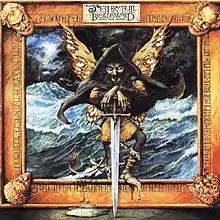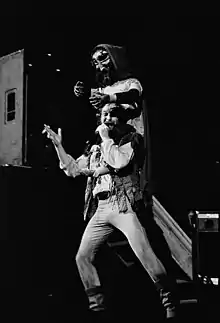The Broadsword and the Beast
The Broadsword and the Beast is the 14th studio album by rock band Jethro Tull, released on 10 April 1982. The album is a cross between the dominant synthesizer sound of the 1980s and the folk-influenced style that Jethro Tull used in the previous decade. As such, the band's characteristic acoustic instrumentation is augmented by electronic soundscapes, provided by new keyboardist Peter-John Vettese. The electronic aspects of this album would be explored further by the band on their next release, Under Wraps.
| The Broadsword and the Beast | ||||
|---|---|---|---|---|
 | ||||
| Studio album by | ||||
| Released | 10 April 1982 (UK) 19 April 1982 (US) | |||
| Recorded | Winter 1981 | |||
| Studio | Maison Rouge Studios, Fulham, London | |||
| Genre | Progressive rock, hard rock, art rock, folk rock, electronic rock | |||
| Length | 38:49 | |||
| Label | Chrysalis | |||
| Producer | Paul Samwell-Smith | |||
| Jethro Tull chronology | ||||
| ||||
| Singles from The Broadsword and the Beast | ||||
| ||||
In the liner notes of the remastered version of the album, Ian Anderson opines that Broadsword contains some of Jethro Tull's best music.
Album information
The cover art is by renowned artist Iain McCaig, a longtime fan of Jethro Tull. The art was made after discussions with Ian Anderson, and was illustrated to capture the concept of the music. McCaig has stated that he intentionally drew hidden "easter eggs" in the album art.[1]
The runic symbols around the edge of the cover are from the Cirth rune system and are the opening lyrics to Broadsword:
"I see a dark sail on the horizon, set under a black cloud that hides the sun. Bring me my broadsword and clear understanding. Bring me my cross of gold as a talisman."
The album was going to be called Beastie, responding to the first track on side one. But during production, the band deliberated over the preference between Beastie and Broadsword, the first track on side two. In the end, they decided (as on Aqualung) to give each side its own title and thus its own identity, and this time to combine both in the album title. As the artwork also puts much more emphasis on Broadsword, many owners and fans also refer to it as the Broadsword album.
Release
In 1984, Mobile Fidelity Sound Lab issued a half-speed mastered edition of the album (MFSL 1-092) which was a minor seller at the time.
The 2005 CD reissue of the album was heavily expanded to include eight bonus tracks recorded during the Broadsword sessions, but not included in the original 1982 album.
Live performance

The tour for Broadsword was the last of the band's to be exceedingly theatrical. It included the entire stage being decorated to look like a pirate ship, which Ian Anderson, as he said in the liner notes for the remastered CD, thought was "very silly". Extensive notes on the production of the album and subsequent tour can be found at the official Jethro Tull website.[2]
In a 1982 concert review, Chris Welch reported: "Squire Anderson waved a huge broadsword dangerously near Martin's nether extremities during songs from their latest album (The Broadsword And The Beast), and punted huge exploding balloons out into the audience. But it was the roar of the band as they got into their heaviest moments that ultimately captivated an audience who seemed evenly mixed between 14-year-old novice Tull freaks and silver-haired rock business veterans. [...] Tull have a vast library of music to perform. They could have played on for another two hours and the audience would have been with them, cheering all the way."[3]
"Cheerio", the final track of the original release, was for some years played as the final encore at Jethro Tull concerts.[4]
Critical reception
| Review scores | |
|---|---|
| Source | Rating |
| Allmusic | |
| Kerrang! | "mixed"[6] |
| Rolling Stone | |
Kerrang! review was ambiguous, calling the album tracks "emotional pieces of composition depending on how much attention you are prepared to give" but overall stated that "If you're a fan, buy it, it may have some pleasant surprises. If, like me, you're not, borrow it from someone who is. You might be surprised too".[6] Rolling Stone magazine, in their two stars review stated: "There's nothing wrong with living in the past, perhaps. Indeed, Ian Anderson can make the wisdom of the ages seem preferable to the rootless philandering of the present day. But on The Broadsword and the Beast, the real beast may be Anderson's penchant for ponderous sermonizing."[8] Bruce Eder of AllMusic was not too impressed with the album. Recalling the production and the music overall, he stated that "this time in the hands of ex-Yardbird Paul Samwell-Smith, is smoother, less heavy, and more thinly textured than their past work, and there are times -- most especially on "Flying Colours"—where they could almost pass for the latter-day Moody Blues, something the band never would have permitted in earlier days".[9]
Former Genesis guitarist Steve Hackett has stated that The Broadsword and the Beast is one of his favourite albums.[10]
Overall sales for The Broadsword and the Beast were better than Stormwatch and A. The album charted at No. 14 in Germany and Norway, No. 19 in the United States and No. 27 in the UK,[11] while the single "Fallen On Hard Times" was a modest hit, reaching No. 20 on the US Billboard Mainstream Rock Tracks Chart.[12]
Track listing
All tracks are written by Ian Anderson with additional material by Peter-John Vettese.
| No. | Title | Length |
|---|---|---|
| 1. | "Beastie" | 3:58 |
| 2. | "Clasp" | 4:18 |
| 3. | "Fallen On Hard Times" | 3:13 |
| 4. | "Flying Colours" | 4:39 |
| 5. | "Slow Marching Band" | 3:40 |
| No. | Title | Length |
|---|---|---|
| 1. | "Broadsword" | 5:03 |
| 2. | "Pussy Willow" | 3:55 |
| 3. | "Watching Me, Watching You" | 3:41 |
| 4. | "Seal Driver" | 5:10 |
| 5. | "Cheerio" | 1:09 |
| No. | Title | Length |
|---|---|---|
| 11. | "Jack Frost And The Hooded Crow" | 3:22 |
| 12. | "Jack-A-Lynn" | 4:40 |
| 13. | "Mayhem Maybe" (with vocals recorded circa 1988) | 3:06 |
| 14. | "Too Many Too" | 3:28 |
| 15. | "Overhang" | 4:29 |
| 16. | "Rhythm In Gold" | 3:08 |
| 17. | "I Am Your Gun" | 3:19 |
| 18. | "Down At The End Of Your Road" | 3:31 |
- The remastered CD added bonus tracks (which had been on the 20 Years of Jethro Tull box-set) and extensive liner notes. Further tracks from the same sessions (and not included on the remastered CD) are "Motoreyes" (from the 20 Years box) and "Crew Nights", "The Curse", "Commons Brawl", "No Step", "Drive On The Young Side Of Life", and "Lights Out" from the outtakes album Nightcap.
Charts
| Chart (1982) | Peak position |
|---|---|
| Australia (Kent Music Report)[13] | 18 |
Personnel
- Jethro Tull
- Ian Anderson – lead vocals, flute, acoustic guitar, Fairlight CMI
- Martin Barre – acoustic guitar, electric guitar
- Dave Pegg – backing vocals, bass guitar, mandolin
- Peter-John Vettese – backing vocals, keyboards, piano, synthesizer
- Gerry Conway – drums, percussion
- Additional Personnel
- Robin Black - sound engineering
- Jim Gibson - artwork
- Leigh Mantle - assistant engineer
- Iain McCaig - artwork, illustrations
- Paul Samwell-Smith - producer
References
- "Cover Story: Jethro Tull - Broadsword And The Beast - Prog". Prog.teamrock.com. Retrieved 1 May 2015.
- Archived 21 April 2007 at the Wayback Machine
- "Jethro Tull Press: Kerrang, 20 May 1982". Tullpress.com. Retrieved 1 May 2015.
- "Jethro Tull live concert set lists and tour schedules at the Ministry Of Information". Ministry-of-information.co.uk. 2 June 2001. Retrieved 1 May 2015.
- Eder, Bruce. The Broadsword and the Beast (1982 release) at AllMusic
- "Jethro Tull Press: Kerrang, 6 May 1982". Tullpress.com. Retrieved 1 May 2015.
- Puterbaugh, Parke (10 June 1982). The Broadsword and the Beast, Rolling Stone
- "Jethro Tull: Broadsword & The Beast : Music Reviews : Rolling Stone". 10 June 1982. Archived from the original on 23 April 2009. Retrieved 1 May 2015.
- Bruce Eder. "The Broadsword and the Beast - Jethro Tull | Songs, Reviews, Credits, Awards". AllMusic. Retrieved 1 May 2015.
- Armstrong, Sam. "Steve Hackett's Top 11 Prog". Udiscovermusic.com. Retrieved 14 October 2018.
- "Album artist 51 - Jethro Tull". Tsort.info. Retrieved 1 May 2015.
- https://www.billboard.com/music/jethro-tull/chart-history/RTT
- Kent, David (1993). Australian Chart Book 1970–1992 (illustrated ed.). St Ives, N.S.W.: Australian Chart Book. p. 155. ISBN 0-646-11917-6.